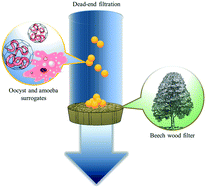Rejection of micron-sized particles using beech wood xylem†
Abstract
The rejection of micron-sized particles mimicking the size of microorganisms responsible for waterborne diseases (such as protozoans) by filters made of wood tissue has been investigated in a dead-end filtration setup. The permeability reached up to 12 000 L m−2 h−1 per bar but a great variability has been observed for the wood filters. The swelling of the samples has been found to be the reason for the drop in permeability over long-term experiments (8 h). After drying the filter for 24 h at 65 °C, the initial permeability could be recovered, hence, this behaviour is reversible. The surrogates used in this study have a size of 5 and 20 μm and their electrostatic properties exclude potential electrostatic interactions. Hence, the removal of the particles occurs only through physical sieving. Microscopy investigations suggest that the surface of the wood as well as anatomical features, such as perforations, contribute to the removal of the particles. The log-removal value (LRV) of the filter depended on the size of the surrogates. In addition, the formation of a filter cake increased the LRV over time for both particle sizes used in this study. A prediction of the LRV has been calculated based on the pore size distribution of the filter rendered by image analysis. The results of the prediction are in accordance with the experimental observations.



 Please wait while we load your content...
Please wait while we load your content...